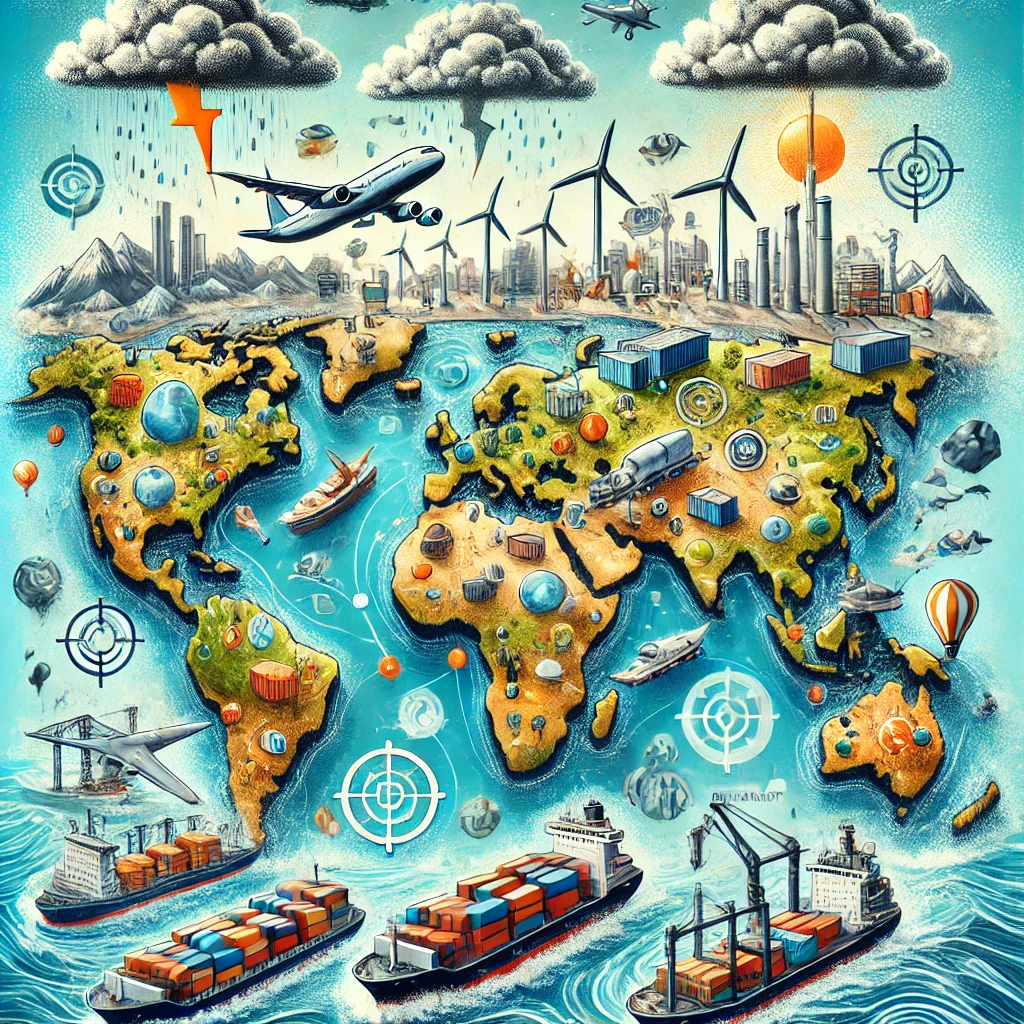Introduction to Sustainable Building Materials
Sustainable building materials are defined as products used in construction that have a minimal negative impact on the environment and are intended to meet the needs of current generations without compromising the ability of future generations to meet their own needs.
This category encompasses a wide range of materials, including recycled content products, renewable resources, and those that promote energy efficiency.
The importance of these materials emerges prominently against the backdrop of climate change and the urgent need for environmentally responsible alternatives in the building sector.
The advantages of using sustainable building materials are manifold. First and foremost, they significantly reduce the carbon footprint associated with construction processes.
By utilizing materials that are locally sourced or made from recycled components, both transportation emissions and the demand for new raw materials are minimized.
Furthermore, many sustainable products enhance energy efficiency within structures, leading to reduced operational costs and less reliance on non-renewable energy sources.
This efficiency is often achieved through improved insulation properties or the use of energy-producing materials, such as photovoltaic panels.
The growing demand for building materials that comply with green standards is increasingly shaping international trade.
Countries worldwide are recognizing the economic and environmental benefits of transitioning to sustainable construction practices.
As a result, there has been a notable increase in the export from India of such materials, positioning the country as a significant player on the global stage.
With initiatives supporting sustainability and awareness around environmental impacts gaining traction, this trend is expected to expand further.
In light of these factors, the significance of sustainable building materials in international trade becomes evident as both a business opportunity and a societal necessity.
Current Trends in the Construction Industry
The construction industry is undergoing a significant transformation, with a marked shift towards sustainable building practices.
This evolution is not only being driven by changing consumer preferences but also by increasingly stringent regulations aimed at reducing environmental impact.
As awareness of climate change and resource depletion grows, the demand for sustainable building materials has surged, leading to a re-evaluation of traditional practices and materials.
One of the primary trends in the industry is the emphasis on energy efficiency.
Building projects are now being designed with energy-saving techniques in mind, leading to a greater adoption of materials that contribute to lower energy consumption.
These materials, which may include highly insulating windows and energy-efficient roofing systems, not only help in reducing a building’s carbon footprint but also offer long-term savings for the occupants.
Furthermore, the focus on waste reduction has become paramount, urging developers to prioritize materials that minimize waste generation during both construction and operation.
Recycled materials are gaining traction within the construction sector, reflecting a broader shift towards circular economy principles.
Many companies are now considering alternative materials derived from recycled sources, such as reclaimed wood and recycled steel, which can significantly reduce the need for virgin resources.
This trend not only conserves natural materials but also encourages a responsible consumption ethos among consumers.
Additionally, evolving regulations at local and international levels are compelling builders to integrate sustainable practices into their projects.
Initiatives to promote the use of eco-friendly building materials are being widely adopted, ensuring that the construction sector aligns with global sustainability goals.
With these systematic changes, the export from India of sustainable building materials is expected to increase as Indian manufacturers adapt and innovate in response to global demands, positioning themselves in the international market.
Global Market Demand for Eco-Friendly Materials
The global demand for eco-friendly building materials has seen a substantial rise in recent years, driven by increasing awareness of environmental issues and a shift toward sustainable construction practices.
According to market research, the eco-friendly building materials market is projected to grow at a compound annual growth rate (CAGR) of approximately 11% between 2024 and 2030.
This growth is evident across various regions, with Europe and North America leading the charge, while emerging markets in Asia-Pacific are also making significant strides in sustainable building practices.
In Europe, countries such as Germany and Sweden are at the forefront, advocating for stringent regulations that promote the use of sustainable building materials.
The European Union has set ambitious goals to reduce carbon footprints, pushing the construction industry to adopt more eco-friendly options.
North America, particularly the United States and Canada, is witnessing a parallel trend, with an increasing number of construction projects opting for green certifications such as LEED (Leadership in Energy and Environmental Design).
Among the types of eco-friendly materials that are in high demand, recycled materials, reclaimed wood, bamboo, and sustainable concrete are particularly noteworthy.
These materials not only reduce the environmental impact of construction but also often provide cost savings over time.
As countries like India ramp up their production capabilities, the export of sustainable building materials is also gaining momentum.
Building materials manufactured in India, known for their eco-friendly qualities, are increasingly finding markets overseas, contributing to both sustainability efforts and economic growth within the country.
Thus, the global market for eco-friendly building materials is poised for significant expansion in the coming years, encouraging a shift in focus towards sustainable construction practices, driven by both market demand and regulatory frameworks worldwide.
Key Players in International Trade of Sustainable Materials
The international trade of sustainable building materials is increasingly influenced by several key players, including manufacturers, suppliers, and distributors.
These entities not only contribute to product innovation but also help in shaping market trends that emphasize sustainability.
One of the primary manufacturers in this sector is Saint-Gobain, which is renowned for its commitment to producing energy-efficient building materials.
Their innovative solutions focus on reducing the environmental impact associated with construction, making them a significant player in the export from India and global markets.
Another notable company is BASF, which specializes in creating sustainable chemical solutions for construction.
They have developed various eco-friendly products that are in high demand across international markets, further bolstering their influence in the export process of sustainable materials.
Furthermore, companies like Kingspan, known for their insulation products, are also positioning themselves as leaders by integrating sustainability into their business models, thus attracting a loyal consumer base interested in green building practices.
Regarding suppliers and distributors, businesses such as Grainger and Ferguson have established themselves as integral components of the sustainable materials supply chain.
They play a critical role in distributing eco-friendly products to builders and construction firms, ensuring that green options are accessible to a broader audience.
Additionally, alliances and partnerships are forming among these players to enhance sustainability efforts globally.
For example, collaborations between manufacturers and local suppliers can streamline the supply chain and foster innovation in sustainable building practices.
As the demand for eco-friendly construction materials continues to grow, the importance of these key players in shaping market dynamics becomes evident.
Their contributions not only promote the use of building materials that are sustainable but also lead to advancements in product development, benefiting the environment and the construction ecosystem as a whole.
Regulatory Framework and Standards
The regulatory framework governing the international trade of sustainable building materials is crucial for both exporters and importers.
In recent years, various international agreements have been established to encourage the use of eco-friendly products while ensuring compliance with safety and environmental standards.
These agreements often promote sustainable practices in the construction industry, thus bolstering the global market for building materials.
For example, the Paris Agreement emphasizes the importance of sustainability, influencing trade policies that favor greener products.
At the country level, each nation has its own set of regulations pertaining to sustainable building materials.
In Europe, for instance, the European Union has implemented strict compliance standards, such as the EU Construction Products Regulation (CPR), which mandates that all construction materials meet stringent environmental benchmarks.
Likewise, countries like the United States have specific regulations set by agencies such as the Environmental Protection Agency (EPA), which oversees the compliance of building materials with health and environmental standards.
Certification programs play a significant role in establishing trust and ensuring that sustainable building materials meet specific criteria.
For instance, certifications such as LEED (Leadership in Energy and Environmental Design) and BREEAM (Building Research Establishment Environmental Assessment Method) assess materials based on their sustainability footprint.
These programs not only guide manufacturers and exporters from India toward compliance but also help consumers make informed choices when purchasing construction materials.
Furthermore, adherence to these certifications can facilitate the export from India by aligning products with international market expectations and reducing trade barriers.
Given this complex landscape, it is essential for businesses engaged in the export of sustainable building materials to remain well-informed about existing regulatory frameworks and standards.
This knowledge will enhance their competitive edge in the global marketplace and assure compliance with varying international norms.
Technological Innovations Fueling Sustainability

The landscape of sustainable building materials is undergoing a significant transformation, driven by remarkable technological innovations that enhance both production and application.
Advances in material science have enabled the development of eco-friendly alternatives to conventional building materials.
For instance, researchers are increasingly focusing on biomaterials, such as mycelium-based composites, which not only reduce carbon footprints but also promote a circular economy by being biodegradable.
Such innovations represent a shift towards more sustainable construction practices as they offer a viable means of reducing the demand for traditional, resource-intensive materials.
Furthermore, advancements in manufacturing processes have led to greater efficiency in the production of sustainable building materials.
Techniques such as 3D printing and modular construction allow for precise fabrication, minimizing waste and optimizing the use of raw resources.
Companies engaged in the export from India of these innovative materials are increasingly adopting these technologies to enhance their competitiveness in the global market while lowering costs and environmental impact.
The integration of smart manufacturing tools, including automation and artificial intelligence, is revolutionizing the production line, enabling real-time monitoring and adjustments to be made to maximize sustainability.
Supply chain management is also witnessing a digital transformation, with technologies such as blockchain and the Internet of Things (IoT) playing a crucial role in improving transparency and traceability.
These tools facilitate the tracking of sustainable building materials from their origin to the final product, ensuring compliance with environmental standards and promoting accountability within the industry.
By embracing such technological advancements, stakeholders can build a more resilient and sustainable framework that not only adheres to current regulations but also anticipates future sustainability challenges.
In conclusion, the continuous evolution of technology in material science, manufacturing processes, and digital tools is essential in shaping the future of sustainable building materials.
The focus on these innovations not only fosters efficiency and cost-effectiveness but also significantly reduces environmental impacts, aligning with global sustainability goals.
Challenges in the International Trade of Sustainable Materials
The international trade of sustainable building materials faces a myriad of challenges that impede its growth and effectiveness.
One prominent issue is supply chain disruptions, which have been exacerbated by global events like the pandemic and geopolitical tensions.
These disruptions can lead to delays in the availability of building materials, making it difficult for construction projects to proceed on time.
The volatility in logistics also affects cost structures, ultimately impacting the pricing of sustainable materials compared to conventional options.
Further compounding these challenges is the aspect of cost competitiveness. Sustainable building materials often require significant initial investment, which can deter consumers and businesses alike from opting for them.
While these materials generally provide long-term benefits, including energy efficiency and durability, the upfront costs can be a financial hurdle.
This challenge is particularly pronounced in developing regions, where budget constraints are tighter, and cheaper alternatives are more accessible.
Thus, achieving a balance between sustainability and affordability remains a pressing concern.
Additionally, there is a critical lack of consumer awareness and education regarding sustainable building materials and their benefits.
Many potential buyers may not fully grasp how these materials contribute to environmental preservation and energy savings.
This gap in understanding hampers demand and slows down market acceptance. Efforts to educate consumers about the advantages of using sustainable materials are essential for fostering a more informed market.
Moreover, the inadequacy of infrastructure in certain regions can hinder the export from India of sustainable building materials.
In many developing countries, the lack of facilities for sustainable construction and insufficient logistical support can thwart efforts to promote these materials.
Therefore, addressing these infrastructural deficiencies is crucial for enhancing the international trade of sustainable building materials and realizing their potential benefits in the global marketplace.
Future Outlook for Sustainable Building Materials Trade in 2024
The international trade landscape for sustainable building materials is poised for significant transformations in 2024.
With an increasing global emphasis on environmental sustainability, the demand for eco-friendly construction options is expected to rise sharply.
This shift is driven by both regulatory pressure from governments aiming to meet carbon reduction targets and consumer preference for greener alternatives in the construction sector.
Market growth in this area is forecasted to be robust, with various reports indicating an annual increase in the trade of sustainable building materials of around 7-10%.
Emerging economies, particularly those within Asia-Pacific, are anticipated to play a crucial role in this growth, mainly due to rapid urbanization and infrastructure development needing sustainable solutions.
Countries like India are becoming prominent players in exporting sustainable building materials, leveraging their abundant resources and innovative production techniques to meet global demands.
Additionally, the market is likely to witness shifts in consumer preferences, with a growing inclination towards locally sourced and recycled materials.
The increasing awareness of the environmental impact associated with traditional building materials is leading to a significant change in purchasing behaviors.
As a result, suppliers are adapting their product offerings to align with consumer demands for transparency regarding sourcing and sustainability practices.
Environmental policies will also be instrumental in shaping the trading practices of building materials during this period.
Governments and international bodies are likely to introduce stricter regulations promoting the use of sustainable materials, which may create new opportunities for exporters who can provide compliant products.
Furthermore, this could also lead to increased investment in research and development to enhance the sustainability of building materials across the supply chain.
Conclusion and Call to Action
As we navigate the complexities of the construction industry, it has become increasingly clear that the demand for sustainable building materials is not only a trend but a necessity for the future.
The transition towards sustainable construction practices is essential to mitigate environmental impact, utilize resources more efficiently, and improve the overall quality of life.
International trade plays a vital role in facilitating the export from India of innovative building materials that adhere to sustainability principles.
Therefore, stakeholders within the industry must collaboratively explore these opportunities to promote eco-friendly alternatives.
Building materials sourced responsibly can significantly reduce carbon footprints and enhance energy efficiency in structures.
Notably, India, with its wealth of resources and burgeoning manufacturing capabilities, stands out as a key player in the global market for sustainable building materials.
The capacity to effectively export from India not only opens avenues for economic growth but also highlights the importance of collaborative efforts to enhance both local and global construction practices.
It is imperative that builders, architects, and policy-makers invest in learning about sustainable options available and their applications in real-world scenarios.
Furthermore, fostering a culture of innovation within the industry will enable the development of advanced techniques and materials that align with sustainability objectives.
By prioritizing partnerships between governments, private sectors, and academic institutions, the construction industry can become a leader in sustainability.
Therefore, we urge all stakeholders to take actionable steps towards embracing sustainable building materials and push the boundaries of innovation.
In doing so, the industry can contribute significantly to a greener, more sustainable future for generations to come.









